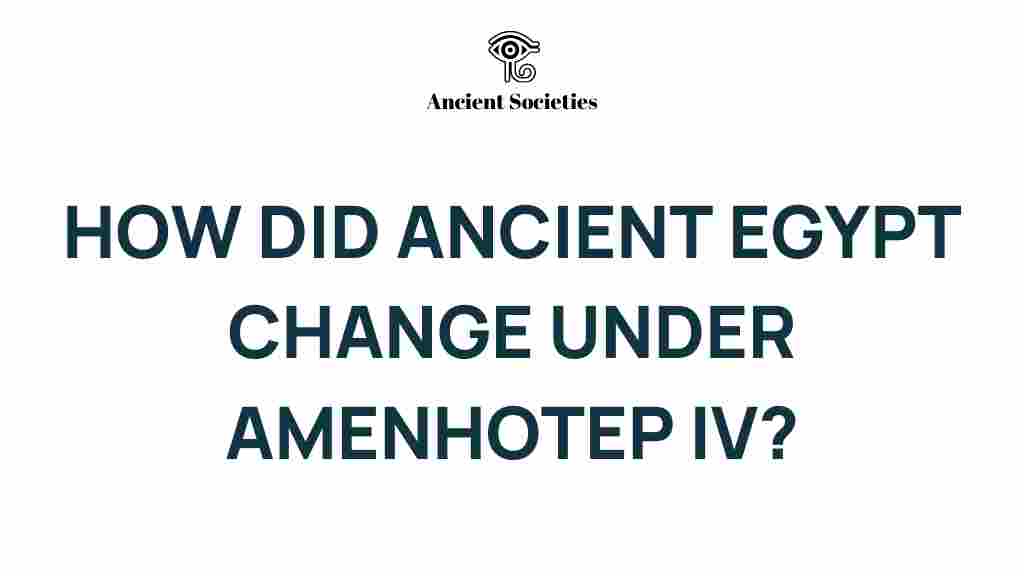Amenhotep IV: Ancient Egypt Transformed
Amenhotep IV, who later changed his name to Akhenaten, was one of the most revolutionary figures in the history of Ancient Egypt. His reign marked a significant shift in the religious, artistic, and cultural paradigms of this ancient civilization. This article explores the profound changes initiated by Amenhotep IV, focusing on his religious reforms, the move towards monotheism, and the lasting impacts on Egyptian society and art.
The Rise of Amenhotep IV
Amenhotep IV ascended to the throne around 1353 BCE, during the Eighteenth Dynasty of Ancient Egypt. His initial years as Pharaoh were marked by the continuation of traditional worship and practices, but he soon began to deviate significantly from these norms. His reign is often characterized by a dramatic transformation that challenged the established order of Ancient Egyptian religion.
Religious Reform and the Birth of Monotheism
One of the most notable aspects of Amenhotep IV’s reign was his radical approach to religion. He introduced a form of worship centered around the Aten, the sun disc, which he considered the sole god. This was a stark departure from the polytheistic traditions that had dominated Ancient Egypt for centuries.
- Rejection of Polytheism: Amenhotep IV sought to diminish the worship of other gods, particularly Amun, who had been one of the most important deities in Egyptian religion.
- The Aten Cult: He established the Aten as the supreme deity, promoting the idea that he, as Pharaoh, was the sole intermediary between the Aten and the people.
- Religious Texts: The Pharaoh encouraged the creation of hymns and texts that glorified the Aten, contributing to the development of monotheistic ideas in Ancient Egypt.
Akhenaten: The Pharaoh of Change
As he transformed into Akhenaten, Amenhotep IV’s commitment to his religious reforms became more pronounced. He established a new capital city, Akhetaten (modern-day Amarna), dedicated to the worship of the Aten. This city served as the center of his religious and political activities.
Akhenaten’s reign was not only about religion; it also marked a significant shift in art and culture. The artistic style of the period became more naturalistic and intimate, reflecting a new approach to representation and expression.
Artistic Revolution Under Akhenaten
The art of Ancient Egypt underwent a dramatic transformation during Akhenaten’s reign. The typical rigid and formal representations were replaced by more fluid and expressive styles. This shift can be seen in:
- Naturalism: Artists began to depict figures in more realistic poses and proportions, capturing the essence of human emotion.
- Family Life: Akhenaten’s depictions of his family, particularly with his wife Nefertiti and their children, showcased a more personal and intimate portrayal of royal life.
- Iconography of the Aten: Artistic representations focused heavily on the sun disc, often showing rays extending down to touch the Pharaoh and his family.
The Impact on Society and Culture
The religious and artistic transformations initiated by Amenhotep IV had profound consequences for Ancient Egyptian society:
- Social Structure: The shift to monotheism challenged the power of the traditional priesthood, particularly those of Amun, leading to tensions within the society.
- Economic Changes: Resources were diverted to support the new capital and the Aten cult, which altered the economic landscape of Egypt.
- Cultural Legacy: The cultural innovations of this period influenced subsequent generations, despite the eventual return to polytheism after Akhenaten’s death.
The Decline of Akhenaten’s Reforms
Despite the initial enthusiasm for Akhenaten’s reforms, a backlash soon emerged. After his death around 1336 BCE, the traditional religious practices were reinstated, and Akhenaten’s legacy was largely erased from history. His successors, including Tutankhamun, restored the worship of Amun and dismantled many of Akhenaten’s innovations.
Challenges and Troubleshooting the Akhenaten Legacy
Understanding Akhenaten’s reign can be challenging due to the limited historical records and the subsequent erasure of his contributions. Here are some tips for navigating this complex historical landscape:
- Cross-Referencing Sources: Use a variety of archaeological findings, inscriptions, and scholarly texts to form a clearer picture of Akhenaten’s impact.
- Contextual Understanding: Consider the broader socio-political context of Ancient Egypt during this time to grasp the motivations behind Akhenaten’s reforms.
- Focus on Art and Architecture: Analyze the artistic changes and building projects of the period, as they offer significant insights into the cultural shifts.
Conclusion: The Enduring Legacy of Amenhotep IV
Amenhotep IV, or Akhenaten, was a visionary Pharaoh whose reign marked a pivotal moment in Ancient Egyptian history. His revolutionary approach to religion, art, and culture set him apart from his predecessors and successors. Although the return to traditional practices shortly after his death diminished his immediate impact, the ideas he introduced continued to resonate throughout history.
In understanding Amenhotep IV’s legacy, we can appreciate the complexities of Ancient Egyptian society and the transformative power of belief and art. His story reminds us that change, no matter how revolutionary, can be both celebrated and contested in the annals of history.
For more on the fascinating history of Ancient Egypt, visit this link.
To explore further about Akhenaten and his reforms, check out this comprehensive resource.
This article is in the category History and created by AncientSocieties Team
